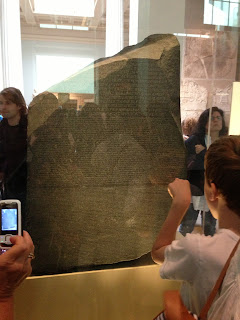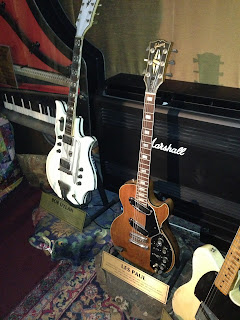Day 15:
We started today at the
British Museum Central Archives. Our guide is the only archivist on staff at the museum, and she is in charge of taking care of the records. They maintain trustee records, financial records, staff records, Reading Room records, and building records. The majority of the records are trustee records, which are very detailed minutes that describe the inner workings of the museum. The trustee records date back to the beginning of the museum in 1753.
The
British Museum is divided into eight different collections departments, and those departments maintain the collections of artifacts and objects, while the archives maintain the collections of letters, journals, etc. The trustee books include letters, Christmas cards, financial reports, minutes, and other information about the museum. Also, they have letter books which have transcriptions of out-going correspondence so that researchers can read the entire conversation.
 |
| Trustee Book |
  |
| Letter Book |
The museum archives only has staff records up to the 1920s, and anything more recent is kept by the Human Resources department instead. These are particularly useful for family history inquiries.
In addition to paper records, the archives also maintains 15,000 photographs, which are hard to catalog when there is very little annotation about location and subject. Some of the photographs are from 1854 and Roger Fenton, who was the first official museum photographer. He took stereoscopic view pictures, so you have to have the stereoscopic viewer glasses to see them in 3D. I got to look through the viewer and look at a picture of an Irish deer.
 |
| Me using the stereoscopic viewer |
 |
| Stereoscopic picture without the glasses |
Building records are also maintained by the archives. Architectural drawings of Robert Smirke's designs for the museum are kept in shallow drawers. Property records for the museum building and surrounding properties are also maintained by the archives. The famed Round Reading Room (which is currently closed and used as an exhibit space and should be open sometime next year) records are part of the archives collections, too. Over 200 boxes contain signature cards and signature books for users from 1790-1973. Many famous names have come through the British Museum in those centuries, including Karl Marx (there are 10 instances of him signing in to the Reading Room), Beatrix Potter, E.M. Forster, T. S. Eliot, Bram Stoker, Rudyard Kipling, etc.
 |
| Rudyard Kipling's Reference Letter |
 |
| Rudyard Kipling's Reading Room Request Letter |
In 1941, the museum was hit by a shell during the Blitz in World War II. The shell exploded when it hit the Coins and Metals display area. I got to hold the exploded shell, which is heavier than I expected.
 |
| Exploded WWII Shell |
 |
| Picture of the damage to the Coins and Metals Department from the shell |
* * *
Before our tour began and after our tour was over, we got to explore the museum, itself. Here are some pictures of some of the exhibits I saw while I was there.
 |
| Pharoah Amenhotep III |
 |
| Rosetta Stone |
 |
| Lely's Venus (Aphrodite) |
 |
| Nereid Monument |
 |
| Parthenon Sculpture |
 |
| Illustration of how the Parthenon used to be painted |
 |
| Sarcophogus |
 |
| Stone Guardian from China (17th c) |
 |
| Easter Island Statue |
 |
| Hunting Tools |
 |
| More Hunting Tools |
 |
| Mummies! |
 |
| Mummies! |
 |
| Cleopatra (perhaps not Queen Cleopatra, though) |
* * *
After the museum, we went to London
Hard Rock Cafe' for lunch. We were lucky enough to get into their vault while we waited for a table. Then, once we were seated, we ate lunch beside a Queen gold record and beneath a guitar belonging to the Eagles guitarist, Joe Walsh. Here are some pictures:
 |
| B.B. King's guitar |
 |
| Bo Diddley's guitar |
 |
| Jimi Hendrix's guitar |
 |
| John Lennon's jacket |
 |
| Temptations picture and lyrics |
 |
| Bob Dylan's guitar and Les Paul's guitar |
 |
| Elton John's outfit |
 |
| Joe Walsh (Eagles) guitar |
 |
| Sting's guitar |
 |
| Queen gold record |
 |
| Queen guitar |
* * *
Finally, we headed to
Westminster Abbey to see the church and all of the memorials to people buried there from Winston Churchill to Queen Elizabeth I to Charles Darwin. They even have memorials to important Brits who aren't buried there such as William Shakespeare. The church itself is so beautiful, and there is so much to see that it's hard to decide where to look! We weren't allowed to take pictures inside, but here are some pictures of the outside:














































No comments:
Post a Comment